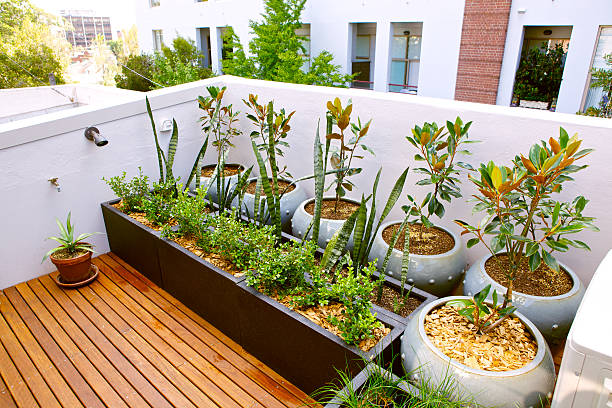εισαγωγή
μπαλκονόκηπο Πώς να ξεκινήσετε έναν κήπο με μπαλκόνι: Αν σας αρέσει να βρίσκεστε κοντά στη φύση, ακόμα κι αν ζείτε σε μια αστική περιοχή με λίγο χώρο, πρέπει οπωσδήποτε να έχετε έναν κήπο με μπαλκόνι. Όχι μόνο τα φυτά στο μπαλκόνι σας θα βελτιώσουν τη θέα από το εσωτερικό, αλλά θα δώσουν επίσης σε αυτή την περιοχή του διαμερίσματός σας που συχνά παραβλέπεται ή υποχρησιμοποιείται μια πραγματική αίσθηση σκοπού.
Για να προσδιορίσετε ποια φυτά μπορείτε να κρατήσετε ρεαλιστικά στο μπαλκόνι σας, θα χρειαστεί να μετρήσετε την περιοχή σας, όπως ακριβώς θα κάνατε όταν ξεκινούσατε έναν κήπο στην αυλή σας. Υπάρχουν πολλές μέθοδοι για να φυτέψετε και να στήσετε με επιτυχία τον κήπο του μπαλκονιού σας, από την εκτροφή λουλουδιών και λαχανικών μέχρι την καλλιέργεια βοτάνων και περισσότερων τροπικών φυτών.
Αρχικά μπαλκονόκηπο , αξιολογήστε την περιοχή σας και την ποσότητα του ηλιακού φωτός.

Πρώτα και πρώτα, πρέπει να αξιολογήσετε όλες τις απαραίτητες προϋποθέσεις για την υγιή ανάπτυξη ενός φυτού και να είστε ρεαλιστές για την περιοχή και το περιβάλλον σας. Προσδιορίστε πόσες ώρες ηλιακού φωτός δέχεται το μπαλκόνι σας, πόσο χώρο έχετε για γλάστρες και δοχεία και πόσο καταφύγιο θα έχουν τα φυτά από τις καιρικές συνθήκες. Αυτό θα σας βοηθήσει να στήσετε τον κήπο του μπαλκονιού σας για να βελτιστοποιήσετε την ανάπτυξη των φυτών.
Σύμφωνα με τον επικεφαλής αγρότη της Αγροτικό τοπίο’s Μάθιου Γκέλντιν, «τα λαχανικά μπορούν σίγουρα να καλλιεργηθούν σε μπαλκόνι». Εάν το μπαλκόνι σας βλέπει νότια ή δέχεται τουλάχιστον έξι έως οκτώ ώρες ηλιοφάνειας κάθε μέρα, αυτό είναι ιδανικό. Για να μετρήσετε την έκθεσή σας στο ηλιακό φως, χρησιμοποιήστε ένα φωτόμετρο ή μια εφαρμογή όπως το Sunseeker. Αυτό θα εγγυηθεί τα φυτά σας.
ΤΟ ΦΥΤΟ ΕΠΙΒΙΩΣΗΣ ΤΟΥ μπαλκονόκηπο

Η επιλογή των φυτών που λατρεύετε είναι απλή, αλλά για να αποφύγετε την απογοήτευση, αφήστε το φως και τον διαθέσιμο χώρο να καθοδηγήσουν τις τελικές σας επιλογές. Δεν θα μετανιώσεις.
«Τι φυτά θα επιλέξετε να βάλετε στο μπαλκόνι σας εξαρτάται επίσης από τον χώρο που έχετε διαθέσιμο», λέει ο Sutcliffe. Όταν αγοράζετε φυτά, λάβετε υπόψη προς ποια κατεύθυνση βλέπει το μπαλκόνι σας και πόσο ήλιο θα δεχτεί κατά τη διάρκεια της ημέρας.
Παρόμοια με το πώς τακτοποιείτε τα πράγματα στο μπαλκονόκηπο μπαλκόνι σας, θα πρέπει επίσης να σκεφτείτε τον καιρό. Αν πρόκειται να φυσάει, μπορεί να πάρετε ιδέες από φυτά που τα πάνε καλά σε θυελλώδη τοπία. Ωστόσο, εάν είστε αποφασισμένοι σε λιγότερο ανθεκτικά φυτά, μπορείτε επίσης να κατασκευάσετε το καταφύγιό σας.
ΕΠΙΛΕΞΤΕ ΛΑΧΑΝΙΚΑ ΚΑΙ ΦΡΟΥΤΑ ΠΟΥ ΕΧΟΥΝ ΠΙΟ ΑΡΓΗ ΣΥΝΗΘΕΙΑ ΑΝΑΠΤΥΞΗΣ
Μπορείτε να φυτέψετε λαχανικά στον κήπο του μπαλκονιού σας, φυσικά, αν αυτό επιθυμείτε. Είτε είστε αρχάριος κηπουρός είτε όχι, επιλέξτε ποικιλίες που είναι συμβατές με το μέγεθος και το περιβάλλον ανάπτυξης του μπαλκονιού σας για υψηλότερο ποσοστό επιτυχίας. Αποφύγετε τις υπερβολές, ακόμα κι όταν είναι δελεαστικό!
Σύμφωνα με τον Geldin, θα πρέπει να επιλέξετε είδη νάνων λαχανικών και φυτών που καταλαμβάνουν εγγενώς λιγότερο χώρο εάν έχετε ένα μικροσκοπικό μπαλκόνι. Τα λαχανικά που αναπτύσσονται καλά σε ένα μπαλκόνι έχουν συνήθως μικρότερα, πιο τακτοποιημένα φρούτα και μια όρθια συνήθεια ανάπτυξης.
Επιλέξτε τα πράγματα που θέλετε να αναπτύξετε.
Κάντε σχέδια για να καλλιεργήσετε τα αγαπημένα σας λαχανικά ή βότανα. Θέλετε να μπορείτε να απολαύσετε τα προϊόντα σας! Τα φυλλώδη λαχανικά, το μαρούλι, το σκουός, οι ντομάτες, οι πατάτες, τα φασόλια και τα αγγούρια είναι μερικά από τα λαχανικά που καλλιεργούνται πιο εύκολα. Τα καρότα, το σπανάκι και τα ραπανάκια είναι απλά φυτά που αναπτύσσονται γρήγορα επίσης.
Δοκιμάστε να φυτέψετε σχοινόπρασο, ρίγανη, δεντρολίβανο ή θυμάρι για βότανα που μπορούν να αναπτυχθούν εύκολα. Δοκιμάστε πρώτα να καλλιεργήσετε βατόμουρα ή φράουλες εάν είστε νέος στην κηπουρική. Δεν θα χρειαστεί να περιμένετε χρόνια για την πρώτη σας καλλιέργεια γιατί δεν καταλαμβάνουν πολύ χώρο και αναπτύσσονται γρήγορα.
Αποκτήστε τα μπαλκονόκηπο απαραίτητα βασικά εργαλεία και προμήθειες.

Αγοράστε ένα δοχείο ή λάστιχο ποτίσματος, τσουγκράνα και φτυάρι. Υπάρχει τόσος διαθέσιμος εξοπλισμός όταν ψωνίζετε για υλικά κήπου που είναι εύκολο να πνιγείτε! Όταν ξεκινάτε για πρώτη φορά, μάθετε τα βασικά. Θα χρειαστείτε μια τσουγκράνα για να ισοπεδώσετε τη βρωμιά, ένα φτυάρι για το σκάψιμο και ένα λάστιχο ή ποτιστήρι για το πότισμα των φυτών σας, τουλάχιστον.
Αυτά τα προϊόντα μπορούν επίσης να αγοραστούν μπαλκονόκηπο χωριστά ή μπορείτε να αναζητήσετε ένα πακέτο που περιλαμβάνει εξαιρετικά εργαλεία για έναν αρχάριο. Θυμηθείτε να μαζέψετε:[3] Ένα μικρό φτυάρι για να βάζετε φυτά ή να τραβάτε τα ζιζάνια. Εάν θέλετε να σημειώσετε σειρές στον κήπο σας, χρησιμοποιήστε πασσάλους και κορδόνι.
Βεβαιωθείτε ότι το έδαφος είναι κατάλληλο για τα φυτά σας δοκιμάζοντας το.
Ελέγξτε εάν το pH του εδάφους είναι μεταξύ 6 και 7,5.[4] Δοκιμάστε το έδαφος τώρα εάν είχατε προβλήματα με την καλλιέργεια φυτών στο παρελθόν. Μπορείτε είτε να ακολουθήσετε τις οδηγίες στο κιτ δοκιμών στο σπίτι είτε να πάρετε ένα δείγμα και να το στείλετε στο τοπικό γραφείο γεωργικής επέκτασης για δοκιμή.
Το pH και η σύνθεση των θρεπτικών συστατικών του εδάφους θα αποκαλυφθούν από τα αποτελέσματα των δοκιμών εδάφους, επιτρέποντάς σας να γνωρίζετε ακριβώς τι πρέπει να προστεθεί για να αυξήσετε το pH σε ένα επιθυμητό εύρος από 6 έως 7,5. Ίσως θελήσετε να παραλείψετε αυτό το βήμα εάν μένετε σε μια περιοχή που είναι γνωστή ως ένα φανταστικό μέρος για να αναπτυχθείτε.
ΕΠΙΛΕΞΤΕ ΤΙΣ ΚΑΤΑΛΛΗΛΕΣ ΓΛΑΣΤΡΕΣ ΓΙΑ ΦΥΤΑ
Εφόσον δέχονται πέντε έως έξι ώρες ηλιακού φωτός κάθε μέρα, οι ντομάτες είναι από τις απλούστερες καλλιέργειες για παραγωγή σε γλάστρες. Δοκιμάστε ντοματίνια ή μινιατούρες αν δεν έχετε χώρο.
Η καλλιέργεια πιπεριών σε δοχεία είναι επίσης μια απλή εργασία. Θα χρειαστούν ένα βαθύ δοχείο—τουλάχιστον ένα πόδι κάτω. Τα κοντά καρότα μπορούν επίσης να φυτευτούν σε ένα μπαλκόνι, εάν έχετε ένα δοχείο αρκετά βαθιά για να χωρέσετε τις μακριές ρίζες τους.
Για να αποφύγετε προβλήματα μούχλας, κρατήστε το φύλλωμα στεγνό και αποφύγετε το υπερβολικό πότισμα. Και τέλος, τα μπιζέλια είναι ένα φανταστικό λαχανικό που λειτουργεί καλά σε δοχεία. Εάν ο χώρος είναι περιορισμένος, προτείνω να επιλέξετε είδη νάνων και θάμνων. υγρό χώμα και κρύο

